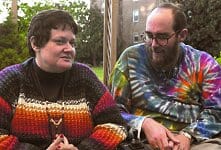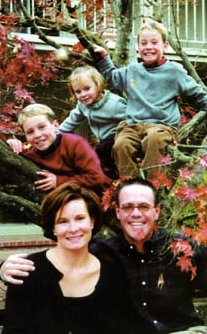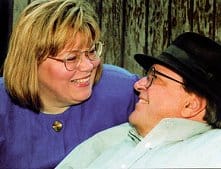
Better Than Chocolate

“Want a piece of chocolate?” Lillian Gonzales politely asked the new guy, Steve Brown, back in 1990 at the World Institute on Disability. Of course he said yes. Not long after, they went out to dinner, which turned into their first date. The night ended over a hot fudge sundae. When they were married on Valentine’s Day in 1992, their wedding cake–baked by a friend’s daughter–was dark chocolate. “He wanted me for my chocolate,” says Lillian.
“Humor keeps our relationship together,” she says, “and knowing how to fight. I was raised with June Cleaver [of early TV fame] and you didn’t fight.” At 49, Steve and Lillian both belong to the “Leave It To Beaver” generation. They have learned “not to push buttons, how to go into separate rooms for an hour or two.”
They also talk about the importance of touch. “When we remember to touch each other,” says Steve, “we usually forget what we’re fighting about.” That touch brings a sense of home, almost on a cellular level, helping to dissipate anger and clear a path that allows communication.
And communication–especially negotiation–helps them cope with pain and fatigue; Steve has Gaucher’s disease and Lillian has Ehlers-Danlos Syndrome. “Some of it’s negotiating around the disability,” says Lillian. “OK, which one of us is in more pain, which one of is going to put a meal together.”
Steve says it all comes down to this: “Is this someone I love, that I want to be with? I always come up with an affirmative answer, so the other stuff can be worked on.”
Accidental Commitment
Holly McGowan was going through what her husband, Tim, calls her “very young woman thing.” She’d been up to her eyeballs in kids–sons Jack and Nicholas were just getting through the diaper years–and now was pregnant again. She began to question if this–the landscaping business she and Tim owned, motherhood, even marriage –was what she wanted in life.

Then came her spinal cord injury four years ago–resulting in T6 paraplegia–while she was still pregnant with Hope, their youngest. She spent six months in the hospital and six more months in rehabilitation in Miami, thousands of miles from their Truckee, Calif., home.
“When I got in my accident,” says Holly, “it recommitted us to each other. In rehab, there was nothing to do but talk! It made me realize what a stellar guy Tim is. It was a wake up call for both of us.” The long hours of talking to each other reminded them of why they fell in love in the first place. “I saw all these wonderful things in him when I was 20, and I ‘rechoose’ him all the time.”
Tim knew he wanted Holly when he first saw her. He’s always been content in the marriage and agrees the accident has brought them closer. The hardest part of Holly’s becoming disabled–for him–was being an emotional caretaker right after the accident. “I tend to go eeeewww,” he says, mimicking the way emotional neediness affects him.
“As I became a person with a disability, and not a disability with a person,” says Holly, “our lives got a lot easier.”
Still Pioneering
“Our neighbors have goats,” says Kathy McBee, speaking of her semirural home in Lutz, Fla.
“All around us are cities and developments, but this community has quite an identity and has been able to preserve it so far,” adds her husband, Fred. While the rest of Florida changes around them, they’ve managed to hang onto what they value in their community; likewise, the love that led to their marriage 34 years ago still binds them.
It began with Fred’s two-year rehab where Kathy worked as a PT. They fell in love and married shortly after Fred moved out into the real world in 1966. He went on to college, becoming an English and logic professor. “It took a lot of courage for Kathy to take this on in the beginning, socially, economically,” says Fred.
“I never had doubts,” adds Kathy. “Once I decided? No, not at all. Of course I had to think a lot about it, but I was absolutely positive that I loved him.” In due time, they had their daughter, Hadley, now 21.
They say their story is about the world around them changing for the better. When they were first involved in wheelchair track and field, for example, meets were sometimes held in parking lots. Athletes meandered out of local hospitals, cigarettes dangling from their lips. Now, the best time in the Boston Marathon is held by a wheelchair athlete. At the beginning of their marriage, access was atrocious. Then came accessibility laws. “Back in 1981 we came across the country, and that was just the time every post office in every Podunk town was building a ramp,” says Fred. “There you were in Slapout, Kan., and they were pouring concrete and putting up a wheelchair sign. We were pioneers.”
Their love for each other has endured the changes. “Cowboy songs would call it ‘darling companion … life partner.’ There’s a lot of words to describe it,” says Fred. “‘Number one best friend’ is another way.”
One word that doesn’t describe it, even after 34 years, says Kathy, is “platonic.”
Love Down Under
In 1988, during his cavalier days, Ian Irwin traveled the world with his mates, “as Australians tend to do.” He stayed with a woman friend and her boyfriend for a few days in San Francisco. The boyfriend became jealous and the situation grew tense. One day, while the group was having an “animated” conversation at a conference for people with osteogenesis imperfecta, Julie rolled up to their table, instantly rearranging their personal dynamics.

Both men began flirting with Julie, who started conversing in sign language with Kate, the other woman at the table. “Should I pay attention to this guy,” signed Julie–meaning Ian–“or should I blow him off?” In no time Ian was smitten with Julie. Before he left San Francisco to continue his American adventure, he asked if she’d meet him and his mates in Honolulu if he paid half her airfare.
Julie agreed, admitting it was madness to go to Honolulu with three guys from Australia at the urging of someone she just met. But once in Honolulu together, they realized two things. First, they really liked each other. Second, they were cursed with cuteness. Because both had OI, people would stop what they were doing to take their pictures, even jumping out from behind light poles. “What a cute little couple. … What crap!” says Ian.
When they returned home, they corresponded for months. Ian came back to California to visit Julie over Christmas and was offered a job organizing an independent living center outside Los Angeles. The only way he could take it was to become a citizen, and the only way he could become a citizen was to get married. So, less than a year after meeting, they took a trip to Las Vegas. Ian helped put the Riverside ILC together. Then he and Julie moved to Sydney, Australia, where they’ve been in love–down under–ever since.
Ian, 51, is a lawyer with the New South Wales Aging and Disability Department and Julie, 40, is coordinator of the New South Wales statewide disabilities strategic plan.
Kindred Spirits
Cyndi Jones and Bill Stothers met on the White House lawn in 1977 during the national push to put teeth into Section 504 of the Rehabilitation Act. Bill knew this was the woman he could spend the rest of his life with. “It was and is a spiritual calling,” he says. So he did what any reasonable man would do; he wined and dined her, inviting her to his home in Toronto. Cyndi told Bill she’d love to go to Toronto with him, but couldn’t because she was scheduled to hold the chalice back home at her church in San Diego that Sunday. “Well, if you change your mind,” he said, “my neighbor has a key.”

When he got home to Toronto, he found her waiting for him in his living room. They married that same year.
It wasn’t long before Cyndi enticed Bill to move from snowy Canada to San Diego. In San Diego, they became work partners as well as lovers, working on Mainstream magazine together. Their newest project is the Center for an Accessible Society, which they co-direct.
How does disability affect their relationship? Since both had polio before they met and both use mobility devices, they knew what to expect. “Admittedly, as we age” says Bill, 60, “it gets harder to travel, and we are starting to grapple with possibly needing attendants.”
Cyndi, 49, agrees. “That is stressful,” she says, “but we keep it light with lots of humor.”
Support New MobilityWait! Before you wander off to other parts of the internet, please consider supporting New Mobility. For more than three decades, New Mobility has published groundbreaking content for active wheelchair users. We share practical advice from wheelchair users across the country, review life-changing technology and demand equity in healthcare, travel and all facets of life. But none of this is cheap, easy or profitable. Your support helps us give wheelchair users the resources to build a fulfilling life. |


Recent Comments
Bill on LapStacker Relaunches Wheelchair Carrying System
Phillip Gossett on Functional Fitness: How To Make Your Transfers Easier
Kevin Hoy on TiLite Releases Its First Carbon Fiber Wheelchair